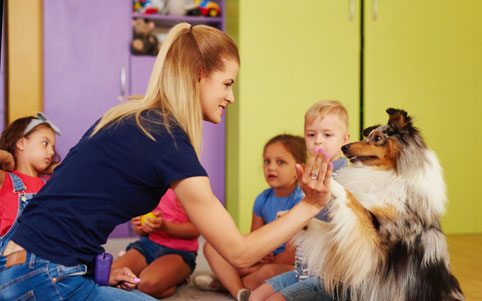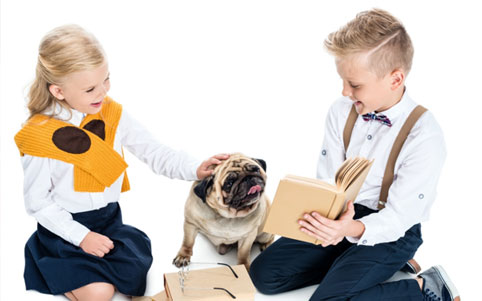Over the last few years, taking dogs into schools has been a growing trend in the UK. The use of school dogs in Australia and the USA has been a massive success in addressing pupil and staff anxiety and stress, and Ofsted have singled out schools with dogs for praise.
Attendance dramatically improves with a school dog on site. For youngsters afraid of the school environment, the doggy greeter at the gate removes or reduces that fear.
There’s quite a bit involved in bringing a dog into a classroom environment, though. Here are some factors to consider and plan for before bringing a furry friend into your school.
1. Using your pet as a school dog
Across the UK, teachers and head teachers are bringing their own beloved pets into schools.
The pooches are proving beneficial for everything from attendance to reducing anxiety, and sometimes doing double-duty as a furry counsellor, with staff finding that kids will talk to the dog while they’re in the room, letting them act on situations and problem areas they otherwise might not be aware of.
2. Is your dog right for the job?
Not all dogs are suited to the school dog life.
You may be better off starting with a young dog that can be trained and grow up on the school property than an older animal that might suffer serious stress when surrounded by children.
School dogs need a steady temperament and easy going natures. They need to be socially confident with a mix of ages, not react badly to loud noises or sudden movement, and enjoy being touched, stroked and petted.
The most successful school dogs seem to come from breeds already often used as service dogs – Labradors, Labradoodles, Golden Retrievers and Jack Russell’s have a great track record – but teachers have had success with everything from German Shepherds to Scottish Terriers. At the end of the day, the most important thing to consider is the dogs temperament, and as a pet owner you’ll know whether your animal is happy around kids or needs more adult company.
It’s still a good idea to stress test the dog and introduce them slowly into the school environment.

3. Don’t skip the training
At the moment, there’s no legislation around dogs in schools in the UK. This has led to the wrong dogs being placed in stressful situations, and dogs that are under stress bite.
The result is a traumatised child and a dog put to sleep.
For the best results, you can work with an organisation that specialises in training therapy dogs. They’ll train your pooch up in a variety of situations, before taking the final step of bringing them into a school.
You can also contact organisations like the Kennel Club for guidance and fact sheets on bringing dogs into schools. The needs of the animal must come first, and any good training programme recognises this.
Ideally, you will be the only person handling the dog in school, and getting training on reading the dogs cues and body language will benefit both of you. Once you read the cues, you can quickly remove the animal before situations get nasty.
If you are getting a puppy specifically for the role of school dog, training and selection of their handler is even more important. You’ll want someone steady, reliable, and able to commit to looking after the dog for years to come.
Not all dogs growl and warn under stress. The cues can be as subtle as ear movements and lip twitches.
Most reputable training centres need the dog to be at least six to nine months old before training starts, and you as the handler will be assessed along with the dog to make sure they’re suitable for the role.
4. Insurance
Working with animals means liability insurance is a must.
Accidents can happen – anything from the dog knocking someone over to getting out of their lead and into traffic. While on school property it’s considered your school dog, so the school will be held responsible for accidents or damage caused by the animal.
Dogs, like any other animal, carry a potential risk no matter how well trained they are. A good policy will outline exactly what is and isn’t covered, and the broker will happily answer any questions you might have.
Pet to school insurance covers you for injury to non-employees and any legal fees that might come up. It’s a good idea to get good vet cover as well; vet bills from an accident or a dog eating someone’s chocolate bar can add up in a hurry.

5. Dealing with allergies and phobias
Allergies and phobias are two areas you need to plan for.
Severe allergies are serious, and no dog is 100% hypoallergenic. Pet allergies are often linked to asthma, and a severe asthmatic attack can result in hospitalisation or death. It’s vital you check with parents whether their child can safely be exposed to a dog.
Aside from making sure the dog is groomed and bathed regularly, there are a couple of steps you can take.
A number of schools have had success reducing the amount of time a dog is in a classroom with allergic students. In severely allergic cases, the dog is not permitted into the same room as the student. Some schools have invested in good quality HEPA filters and air purifiers to reduce the chance of exposure.
It’s not just kids that are potentially dog-phobic – adults that have been bitten often have trauma. The important thing here is to respect the situation: if someone doesn’t want to be near the dog, do not bring the dog near them. With a lot of kids, having the dog in the room and seeing others pet them helps overcome the fear barrier, but it’s important not to force contact. When or if the child is ready to approach the dog, they’ll do it.
In some cases, it might be better to keep the dog out of the room while the phobic person is present. A student, teacher, or visitor that is terrified of the animal will not be comfortable, and the dog will pick up on that through scent and action. It adds to the stress on the dog as well as the person suffering the phobia.
Each situation should be evaluated on its own merits, and acted on accordingly.
6. Doggie homing and vet responsibilities
If the dog is a personal pet that is being trained, you need to decide if the school is covering those bills, and whether the costs will be recovered if the owner leaves their post. The same can be applied to off-site vet bills; and make sure you check your vet insurance to see if the policy covers those.
The dog needs to be homed with their assigned handler. If the dog is considered a school asset, the school needs a budget to cover the costs of food, toys, flea treatments and vet care while in the home.
It’s also important to choose the handler wisely; if you pick a staff member who changes jobs in a couple of years, rehoming the dog will cause trauma to both human and pooch. Plus you’ll have the expense of training the new handler, with the risk of the cycle to repeating itself later.
There’s a reason the majority of school dogs are head teachers or senior members of staff bringing their personal pet in. Senior staff or the school head are usually in a stable, fixed role that is unlikely to change at short notice, providing stability to the dog and the students that benefit from having it on the property.
7. Alternative day care and handler off days
School dogs cannot and should not be expected to attend every day. The dog needs a break from constant stimulation, and you’ll be able to tell pretty quickly when it’s time for a break day.
You still need to go to work – so who is looking after Rover? A good quality doggie day care, or is there someone at home to watch the pooch? If you go for the day care option, it needs to be budgeted for.
8. Care and feeding on school grounds
You’ll need a quiet space for doggy decompression from the noise and bustle – and that does not mean a crate in a classroom.
Even the best trained dog will need a break from the constant noise and movement. Overstimulation is a serious threat for school dogs, and one of the reasons the handler needs to be trained along with the dog.
The dog will also need regular bathroom breaks and exercise, access to fresh water and food, a favourite toy and a blanket that’s just for them.
A school dog can make a huge difference for students while teaching empathy, confidence and patience.
Plan wisely, get the proper training for the dog and handler, and make sure your budget covers contingencies, and you’ll have a rewarding school dog experience.